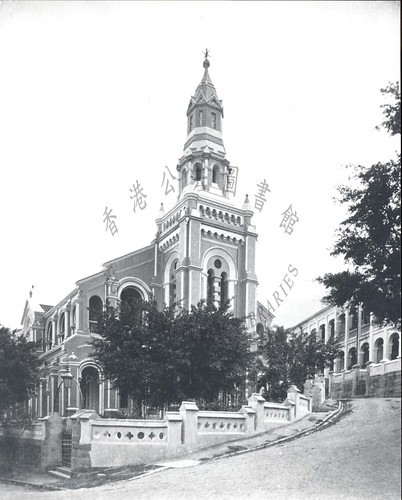Where: The photographer was up on Hospital Road, looking north-east across Tai Ping Shan to the harbour, and Tsim Sha Tsui beyond. Here's a copy marked up with some of the roads in the area (click the photo for a larger copy you can zoom in to):
What: Most of the area is densely-packed housing, but there are a few larger buildings and landmarks we can identify. The best group is down in the bottom-left corner:
The open area at the top is marked "Possession Point" on an 1889 map [1]. It's still an open area today, now called Hollywood Road Park.
Just south across Hollywood Road there's a church on the corner of Po Yan Street. It's the original St Stephen's church in Hong Kong [2], founded here in the 1860s.
South again across New Street is the compound of the Tung Wah Hospital [3], with several grand buildings there. To the right across Po Yan Street is a building under construction. When it is finished, it will be an extension to the Tung Wah Hospital.
Up on the seafront, this building with its larger windows stands out as something different from its neighbours.
It was a government building, the Harbour Master's office [4].
Following the shoreline along to the right, there's a ship docked at a pier:
That 1889 map shows it joined the Praya (today's Des Voeux Road) roughly where the junction with Man Wa Lane is today. However it doesn't note the name of the pier or the shipping company that used it - can anyone identify it?
When: We'll look across the harbour for clues.
The building is the old Marine Police Headquarters [5] in TST. The building was finished in 1884, so the photo can't be older than that. And it looks as though the time ball is visible on top of the round tower to the right. That went into service in 1885, so we're looking at 1885 or later for this photo.
Another 1880s photo in my collection [6] also shows the TST shoreline. Here's a comparison:
The upper photo looks newer, as it shows an extra pier at the Kowloon Wharves, and additional development underway in front of the Marine Police HQ.
We know that the upper photo can't have been taken later than 1888, as it shows the Roman Catholic Cathedral (finished in 1888) is still under construction. That narrows down the date range for this photo to 1885-1888.
I'd provisionally dated the newer photo to 1886, which would narrow down the dates for the present photo even further to 1885-6. However, another source suggests 1887, based on the Tung Wah extension that's under construction. Mr Cheng Po Hung comments [7]:
that the location of the Tung Wah Hospital expansion, which was under construction in the photo, was ((previously)) a cinema ((probably a theatre)).The cinema was burnt in c1885. The Tung Wah Hospital then acquired that land and built the new hospital. so the date of this photo should be around 1887.
A search for "Tung Wah" in the newspapers didn't turn up any mentions of this extension, so I haven't been able to confirm the date. I'll stick with early 1886 as my guess for this photo's date, but corrections are welcome.
Who: The only people we can see are the bricklayers, hard at work on the Tung Wah extension:
Here they're working on straight walls, but we can also see they wooden forms they've made to help them build neat brick arches:
Trivia: Here's how the photo looked before restoration:
That line sweeping down across the photo looks like a bad scratch, but in fact there isn't any damage to the photo's surface. Instead it was caused by a crack in the glass plate negative. The crack hadn't completely broken the plate in two yet, so the photographer was still using it to make prints for sale. But you'd wonder how many customers would buy the photo with a line across it like this.
From the other photos it was sold with, I guess that the original owner bought it around 1900. The glass plate was already over 10 years old, and coming to the end of its life.
References:
- "(1889) The City of Victoria", Plate 3-2, Mapping Hong Kong
- St Stephen's Church
- Tung Wah Hospital
- Harbour Master's Office
- Marine Police Headquarters
- c.1886 View over Central and the Harbour
- Mr Cheng's comments: http://gwulo.com/node/5132#comment-11166















































































































































